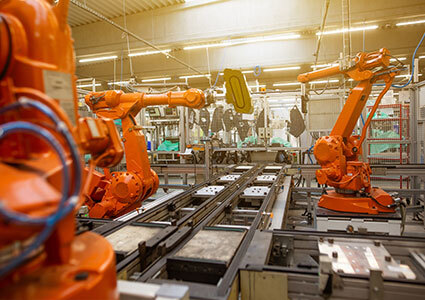Unlocking business value with a three-pronged smart factory set up
For the manufacturing sector, success hinges on the integration of digital and physical systems, heightened visibility, and increased flexibility. A digital first approach certainly reduces costs and increases efficiency – but what is leading the charge? All signs point to smart factories, powered by a combination of smart technologies and a new customer experience mindset. Their adoption rates are rising. The global smart factory market is now expected to grow at a CARG of 9.52 percent from $128.74 billion in 2022 to $321.98 billion by 2032.
Kevin Bull highlights how manufacturers can unlock new value across their ecosystem by going smart in three areas.

An important part of a smart factory setup is unlocking Industry 4.0 technologies to provide new manufacturing efficiencies. But for this digital strategy to work, manufacturers must become more agile – and they know it with 63 percent of manufacturers prioritizing agility over the next 12-to-14 months.
Unlike their predecessors, smart factories rely on contemporary technology to allow manufactures to be more adaptable to real-time changes and operate automatically. The pay off? A smart factory makes every value chain link connected, informing manufacturing decisions instantly.
The three critical components to creating a smart factory are making decisions based on data-driven insights, using reactive and proactive demand forecasting, and an effective customer experience and engagement strategy – all underpinned by cutting-edge technologies.
1. Smart systems – getting the right information to the right people at the right time
Data-driven insights are crucial for manufacturers, but data management remains a huge time sink for many businesses that still rely on legacy systems as they can’t share data with other business systems. To improve efficiency and production, a horizontal integration is required between operational systems and vertical integration through connected systems, on top of an end-to-end holistic integration throughout the entire value chain. So how can manufacturers make this happen?
Firstly, the business process causing the most pain and its data must be identified and analyzed for inaccuracies. This will allow manufacturers to build a data strategy to reduce waste and optimize the data value stream with smart technologies.
Integrated data collecting and analytics tools such as a CRM and ERP systems can help manufacturers maximize productivity by removing data siloes, reducing manual labor, and provide an entire view of customer habits. This in turn, helps manufacturers offer a more personalized experience and track customer behavior that supports future growth opportunities.
2. Replace reactive operating models with proactive ones to optimize production
For manufacturers to become more efficient, productive, and increase margins they must move from a reactive operating model to a proactive, predictive one that leverages collective data. Actionable insights from smart technologies can provide connected digital feedback which enables real-time operational optimization. This ensures organizations can proactively leverage new knowledge across the value chain.
Demand forecasting aims to predict future demand to allow manufacturers to get ahead of the game but unknown parameters such as supply, transport, and lead time problems can cause production scheduling, inventory planning, and transportation to be affected. This is where machine learning can help manufacturers with demand forecasting by using economic and consumer conditions in the marketplace to predict future customer conditions. It’s the first step in production planning and a key requirement to addressing uncertainties in supply chains. But the benefits don’t stop there.
Accurate demand forecasting can enable manufacturers to make informed decisions about production, inventory, and staffing to avoid shortages or overages. This will help manufacturers reduce operating costs, improve efficiency, and increase profits and help deal with periods of uncertainty.
3. From top to bottom – adding CX value is a company-wide effort
Digital customers are now more connected with more options, so if their needs aren’t being matched, they will take their business elsewhere. Manufacturers need to rethink their customer experience and engagement approach and research shows 63.73 percent of manufacturers are already prioritizing their customer experience. But how can smart tools help?
 As more buyers move online, manufacturers must meet them there with personalized experiences. The whole customer experience doesn’t need to be digitized – simply digitizing product catalogues can be a step towards improving customer experience – as essentially, it’s all about giving customers more autonomy.
As more buyers move online, manufacturers must meet them there with personalized experiences. The whole customer experience doesn’t need to be digitized – simply digitizing product catalogues can be a step towards improving customer experience – as essentially, it’s all about giving customers more autonomy.
Due to lowering prices of IoT sensors, state-of-the-art mobile devices, and cloud-based statistics aggregation, manufacturers can enhance service standards and margins by providing remote tracking and proactive maintenance that complement damage/restoration assist.
Smart Factory – the next chapter for manufacturers
With cutting-edge technology, smart factories operate faster with increased precision when compared to traditional factories. These smart technologies are leading manufacturers into a more connected and automated future, which will unlock new efficiencies and productivity.
For a list of the sources used in this article, please contact the editor.
Kevin Bull
www.columbusglobal.com
Kevin Bull is Product Strategy Director at Columbus UK, a global digital consultancy headquartered in Denmark. Columbus employs around 1600 digital advisors and consultants on the manufacturing, retail & distribution, food & process, and life science industries. It offers end-to-end digital services and solutions within sustainability, strategy & change , cloud ERP, data & analytics, application management, digital commerce, and customer experience. Columbus has offices and partners all over the world, and delivers its solutions and services locally – on a global scale.
